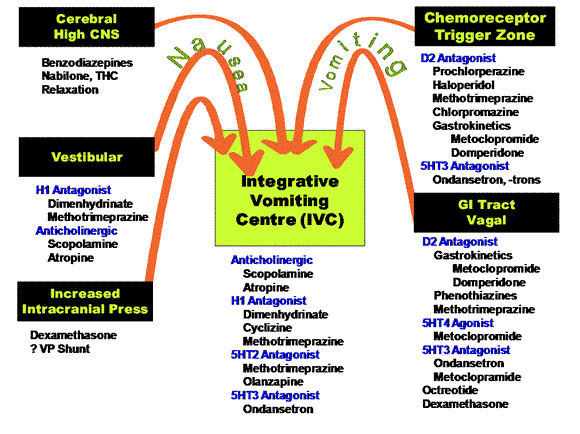Non-Pain Symptoms
Nausea and Vomiting:
Nausea and vomiting is one of the most common symptoms in palliative care.
It occurs when the vomiting center of the brain is activated by different mechanisms including:
- The cerebral cortex
- Vestibular apparatus
- Chemoreceptor trigger zone (CTZ) located in the floor of the fourth ventricle
- Vagus nerve
- Direct action on the integrative vomiting center (IVC) located in the ventricular formation of the medulla oblongata.
Causes:
Identifying the etiologic mechanism is important as the list of potential causes and treatments will differ. Some common causes include:
- Gastrointestinal problems
- gastroesophagical reflux
- gastric irritation/ulceration
- constipation
- ileus
- obstruction total/partial
- infections (gastroenteritis)
- Metabolic abnormalities
- hypokalemia
- hypercalcemia
- renal/ hepatic failure
- Drug side effects
- opioids
- steroids
- nonsteroidal anti-inflamatory drugs
- chemotherapy
- Raised intracranial pressure
- Anxiety
Opioid induced nausea and vomiting
- frequently resolves spontaneously a few days after the initiation of treatment(6)
- Opioids stimulate the CTZ centrally and decrease the gastric motility.
- Constipation is the most common secondary effect and prophylactic measures should be always considered (4).
Treatment:
Non pharmacological
- General recommendations such as offering small portions of food, avoid smells and techniques for decreasing anxiety can be beneficial.
Pharmacological
Treatment should be started depending on the potential etiology.
Different mechanisms can be involved in the same patient therefore the use of more than one drug is frequently seen in palliative care.
It is important to keep in mind that in many cases it is very difficult to achieve relief and the whole process can be very challenging and stressful for health practitioners and family members.
The following diagram from Downing, M(4) provides a clear idea of all the different mechanisms involved in this complex symptom.

5-HT 3 Antagonist
- Ondansetron acts blocking the 5HT3 receptors centrally at the CTZ and IVC sites and peripherally in the gut(4).
- Serotonin is released from the enterochromaffin cells in the gastrointestinal mucosa in response to injury, for example chemotherapy or radiation.
- Common side effects are headache and constipation.
Commonly used dose:
Ondansetron 0.2 mg/kg/dose q 8-12 hr PO. Max 8 mg/kg/dose.
Dopamine receptor antagonist
- There are major dopamine neurotransmitters in gut and CTZ.
- Two groups of D2 antagonist are often used:
- 1. Antipsychotics: Haloperidol (extrapiramidal effects can be seen), Methotrimeprazine (Nozinan)
- 2. Prokinetics: Domperidone, Metoclopramide.
Antihistamines
- These act on the H1 receptors in the vestibular system and IVC.
- These drugs should be used as first line therapy in motion sickness.
- Dimenhydrinate (Gravol) is commonly used and the main secondary effect is sedation.
Commonly used doses:
Gravol PO/IV 1-2 mg/kg q 6-8 h.
Corticosteroids
- Dexamathasone is the first line therapy for raised intracranial pressure.
- Corticosteroids seem to be very effective in relieving nausea and vomiting when a brain tumor or metastasis are involved.
- Because of its antinflammatory effect the surrounding edema and pressure are decreased with secondary symptom improvement.
- Usually corticosteroids are given for a limited time only due to their significant side effects.
Commonly used dose:
Dexamethasone PO/IV : 0.1-1 mg/kg/dose q 6-8 h.

